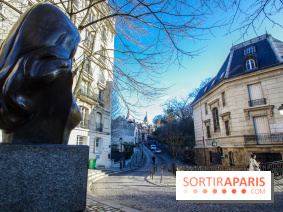On Monday October 21, 1680, thecultural institution La Comédie-Française, the result of the merger between the only two Parisian troupes of the time, that of the Hôtel de Guénégaud, Molière's former troupe, and that of theHôtel de Bourgogne, was founded by royal decree of Louis XIV.
Also known as the Théâtre-Français, this was the first permanent troupe of Comédiens-Français, created by the sovereign for several reasons: to compete with Italian troupes at a time when the Comédie-Italienne was in great demand, to promote French classical theater while reaffirming the power of the monarchy, and to put an end to the sterile bickering between the two rival Parisian troupes.
In 1658, Molière's troupe made its debut at the court of Louis XIV, and the playwright quickly became a favorite of the young king, for whom he designed a plethora of shows in collaboration with the best stage architects, choreographers and musicians of the day. But in 1673, the playwright died at the age of 51, just hours after performing the title role in Le Malade imaginaire for the fourth time.
Deprived of its mastermind, the King's troupe, now directed by Molière's widow Armande Béjart and her stage companion Charles Varlet dit La Grange, was bled dry. The rival troupe at the Hôtel de Bourgogne took advantage of the drama to solicit several actors, including Michel Baron, La Thorillière and the Beauval couple, who left Molière's troupe to join their own.
On October 21, 1680, seven years after Molière's death, Louis XIV ordered the merger of the troupe du roi, based at the Hôtel de Guénégaud on rue Mazarine, and the troupe du théâtre de Bourgogne, thus unifying the comic and tragic troupes. The Comédie-Française was born.
The first joint performance was given a week later, and the Comédie-Française adopted a significant motto: "Simul et singulis", "To be together and be oneself". From then on, the troupe alternated between performances of comedies and tragedies. The repertoire included all the plays by Molière and Racine, plus a few by Corneille, Scarron and Rotrou.
This merger was also a way for the sovereign to highlight classical French theater while reaffirming the grandeur of the French monarchy, at a time when the Comédie-Italienne was very much in vogue. As a result, the king granted the French comedians a monopoly on French-language performances in Paris, as well as a generous pension of 12,000 livres. Within the troupe itself, they were divided into a hierarchy of "pensionnaires" and "sociétaires", with the possibility of participating in the management of the theater.
Initially established at theHôtel de Guénégaud, the Comédie-Française was forced to move several times over the following century. Expelled in June 1687 from the Hôtel de Guénégaud by order of the King, on the pretext that they risked disturbing the peace and quiet of the Quatre-Nations religious college, the actors moved in 1689 to the Jeu de Paume de l'Étoile, then to the Palais des Tuileries, and finally in 1782 to the Odéon theater, then called the Hôtel de Condé, where the troupe performed for the first time Beaumarchais' play Le Mariage de Figaro, previously censored for its harsh criticism of nobility and aristocracy.
Hitherto under royal protection, with the sovereign and the gentlemen of the King's Chamber having the power to decide on the details of the program, as well as the selection of the actors, the latter's status changed at this time. Now endowed with civil rights, they were stripped of their royal pension and monopoly on the French repertoire.
But during the French Revolution, under the Terror regime, the Comédie-Française's overly monarchist ideas led to its closure on September 3, 1793, by order of the Comité de Salut Public, and the imprisonment of its actors. Escaping the guillotine, the troupe, somewhat dissolved by a split between pro-monarchists and pro-republicans, was re-established in 1799 by the Directoire.
With the help of writer François de Neufchâteau, who became Minister of the Interior, the Comédie-Française took up permanent residence at the Théâtre français de la République, the Salle Richelieu built in 1786 byarchitect Victor Louis on the edge of the Palais-Royal after the Salle de l'Opéra had burned down in 1781.
In vogue during the First Empire and the early years of the Restoration, the Comédie-Française enjoyed the protection of Napoleon 1st, whose Moscow Decree of 1812 governed its operation and organization. In 87 articles, the Emperor set down on paper the rules governing theatrical administration, troupe funding and the admission of new plays - measures that are still in force today.
Now under the supervision of the Ministry of Culture, the Comédie-Française now has three theaters in Paris - the Salle Richelieu, the Théâtre du Vieux-Colombier and the Studio-Théâtre - where it performs a repertoire of 3,500 plays, mainly classical, but also more modern productions by foreign authors.
Although he had been dead for seven years when the Comédie-Française was founded, Molière is still regarded as the patron saint of the French institution, also known as the House of Molière. The chair in which he began to agonize, during the performance of Le Malade Imaginaire, is still on display at the back of the Galerie des Bustes, past the public foyer, in the Salle Richelieu.
For further information
Location
Comédie française - Salle Richelieu
1 Place Colette
75001 Paris 1
Access
Metro Palais Royal - Musée du Louvre
More information
Iconography: Header: Interior of the Comédie-Française in 1790 Molière's troupe Molière's death The Odéon theater The French theater of the Republic, Salle Richelieu































